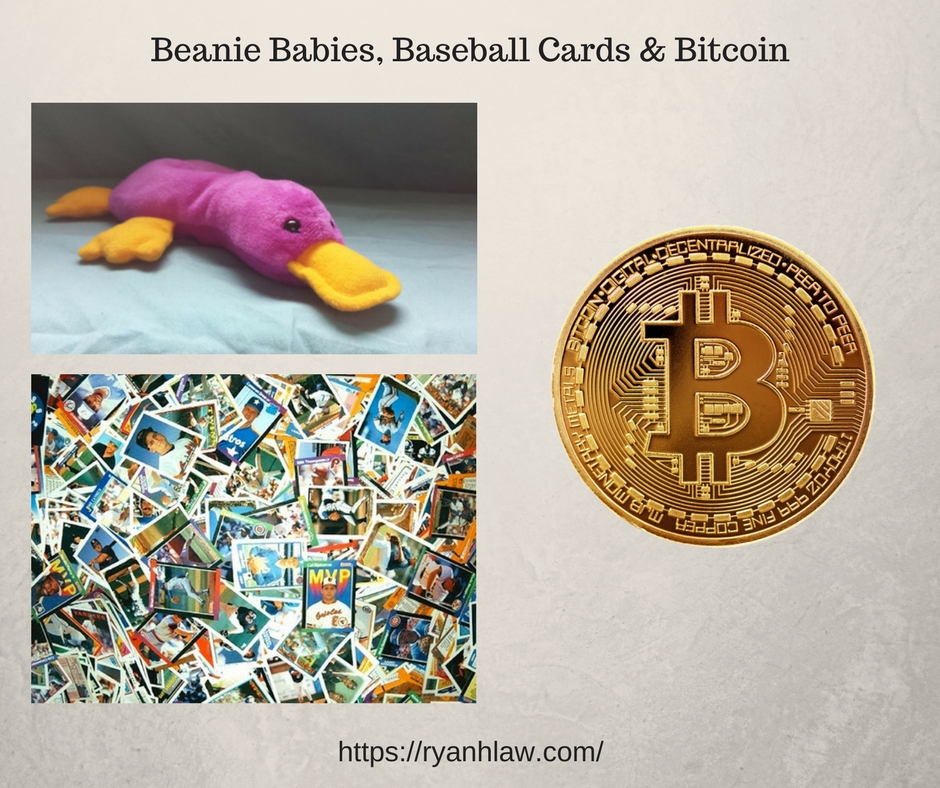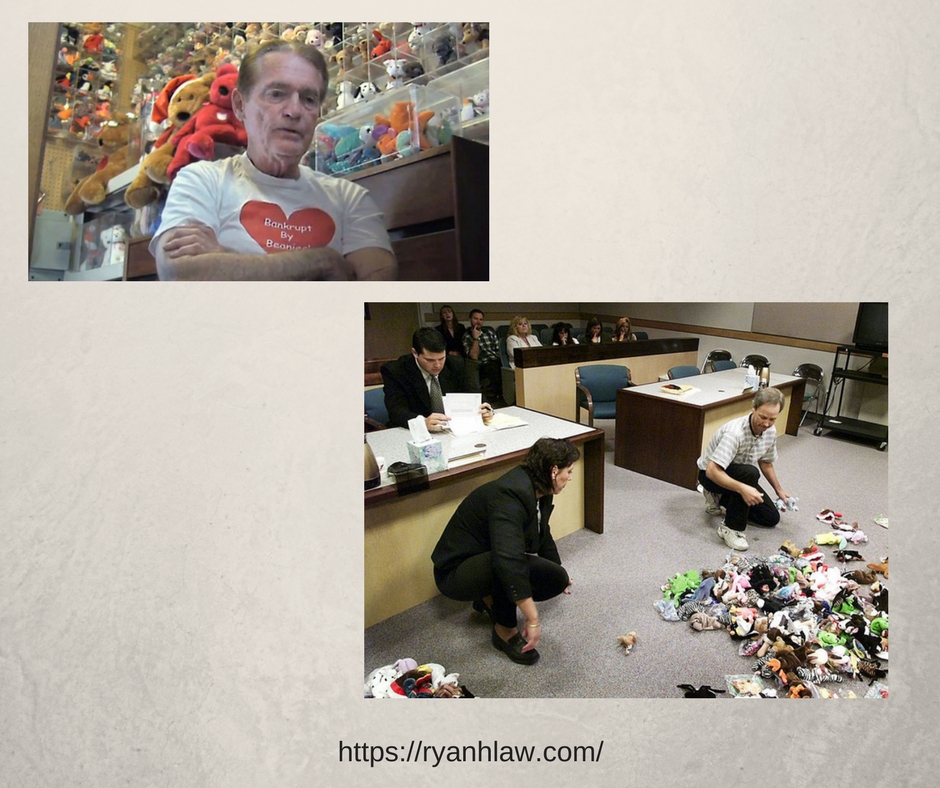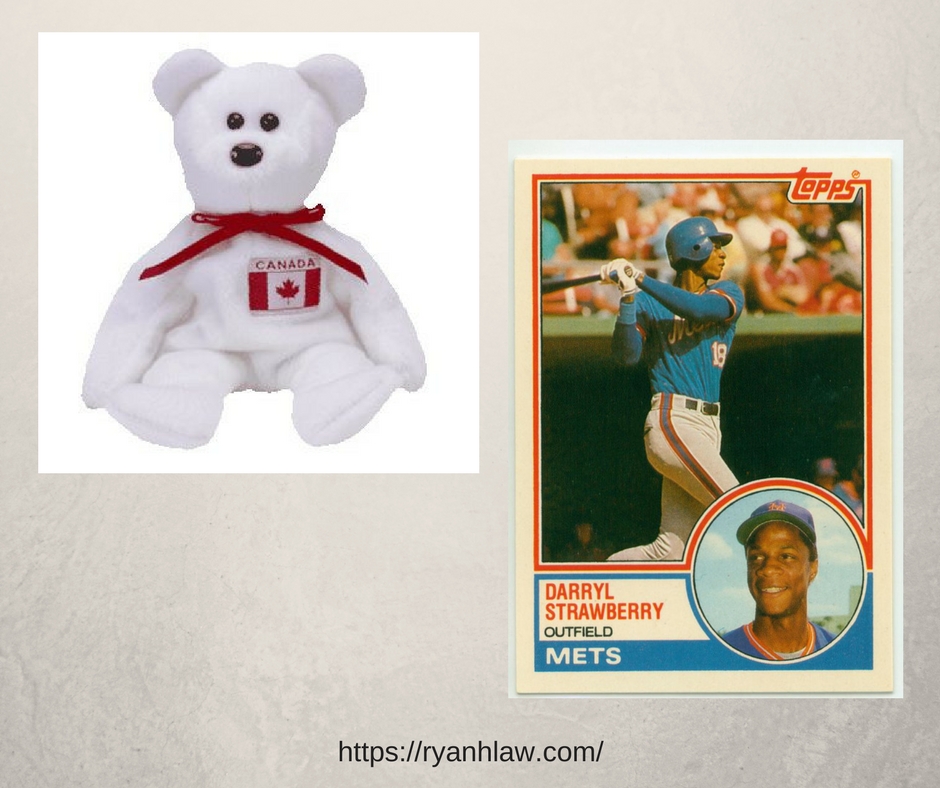
What do Beanie Babies, Baseball Cards and Bitcoin have in common?
None of them are a good investment.
For those unfamiliar with Beanie Babies, they are a stuffed animal that became a fad in the mid-90’s. Ty Warner, Inc. created the toys but strategically only produced a limited amount of each new stuffed animal and retired them regularly. People would wait for hours and hours for the chance to buy one of the limited ones, then they would sell them for as much as ten times the price, mainly on Ebay. At one point Beanie Babies made up 10% of Ebay’s sales!1 People spent fortunes buying and carefully storing them. The bubble, of course, burst, and now those bins of Beanie Babies are essentially worthless. There are stories of people going bankrupt after spending over $100,000 on the toys2 or carefully sorting their Beanie Babies in a divorce.3

And how about baseball cards? This was a fad of the late 80’s and early 90’s. Topps, Score, Donruss and Upper Deck were among the companies that printed millions of cards and were religiously collected by almost every boy in America (myself included). Baseball card shops opened up all over the nation, and a price guide printed monthly by Beckett detailed how much each card was worth, often driving the market by setting prices. While a Mickey Mantle or Honus Wagner card might be worth a lot, the remainder are essentially worthless. It was a bubble that was bound to burst.4
Both Beanie Babies and baseball cards produced no real value – they were hyped up by the market and the prices were artificially inflated. Again – these items held no intrinsic value – they did not produce any further value. If you like Beanie Babies or baseball cards because you enjoy them, great, but if you bought them as an investment it was a bad gamble.
 Enter Bitcoin.
Enter Bitcoin.
Without getting technical, Bitcoin is a form of currency (called cryptocurrency). It is “mined” by massive computers running complex algorithms. According to a Bitcoin forum5 someone trying to mine bitcoins on a home computer will mine about 0.00001406 bitcoins per week, which means it will take well over 1,000 years to mine 1 Bitcoin.
Clearly mining isn’t the way to make money.
The basic idea behind cryptocurrencies like Bitcoin is that there is no bank or government or currency backing it up. If you own a Bitcoin you own an electronic coin that you can (hypothetically) use to purchase items (although the documentary Life on Bitcoin6 shows how hard that can be).
The basic idea would be that if a Bitcoin was worth $1, you could buy a $1 drink for 1 Bitcoin. You transfer ownership of that Bitcoin to the company selling you the drink. If a Bitcoin is worth $2 you would transfer ½ a Bitcoin to buy that drink. The new owner can either spend it or save it.
People buy Bitcoins in hopes that they will go up.
For early adopters, it went well. In 2010 the highest price was 39 cents. Bitcoin hit its high price on December 17, 2017 at $19,843.11.7 If you bought 100 Bitcoins at 39 cents each and sold them on December 17, 2017 you would have made $1,984,272 ($1,984,311 minus $39 initial investment). Not bad, right?
Wait – you didn’t buy any when it was 39 cents?!? Too bad. I didn’t either.
Let’s say you wanted to buy Bitcoin starting in 2018. On January 1 it closed at $13,500. It reached a high on January 6 at $17,152. On January 22 it closed at $10,823. Will it go back above $13,500? It’s hard to say. It might, but it might drop back down to $100.
By the way, let’s say you owned one Bitcoin when it was worth $10,289.26. To buy that same $1 drink with Bitcoin you would transfer 0.000097 Bitcoins. There’s some fun math for you!
However, people aren’t buying Bitcoin to buy a $1 drink (there are few places in the world where one can do that). They are buying Bitcoins in hopes that someone else will buy them for more. It is a purely speculative investment, with far more risk than most people should take on.
Maybe I’m wrong.
Maybe you can buy one Bitcoin today at $10,832 and it will be worth $100,000 next year.
Maybe it will be worth 39 cents.
That’s what speculative investments do.
Yes, there are cryptocurrency millionaires. There are also others who have lost far more than they could afford to. When people realize that there is no intrinsic value in Bitcoins they will have nothing.
Hopefully they can find comfort in their Maple Bear Beanie Baby while holding their Daryl Strawberry rookie card.
I recommend that you stick to real investments where real value is being created. Slow and steady wins the race. If you really, really want to buy Bitcoin never invest more than you can afford to lose, and speculative investments should never make up more than about 5% of your total portfolio.

- http://fortune.com/2015/03/11/beanie-babies-failure-lessons/
- http://www.dailymail.co.uk/news/article-2377645/Family-goes-bankrupt-blowing-100-000-savings-Beanie-Babies-thought-valuable.html
- https://www.huffingtonpost.com/entry/beanie-baby-fever-in-1999_us_58af7d12e4b060480e0661fe
- http://www.slate.com/articles/sports/sports_nut/2010/03/the_great_baseball_card_bubble.html
- https://bitcointalk.org/index.php?topic=556189.0
- http://lifeonbitcoin.com/
- http://markets.businessinsider.com/currencies/historical-prices/BTC-USD


Leave a Reply